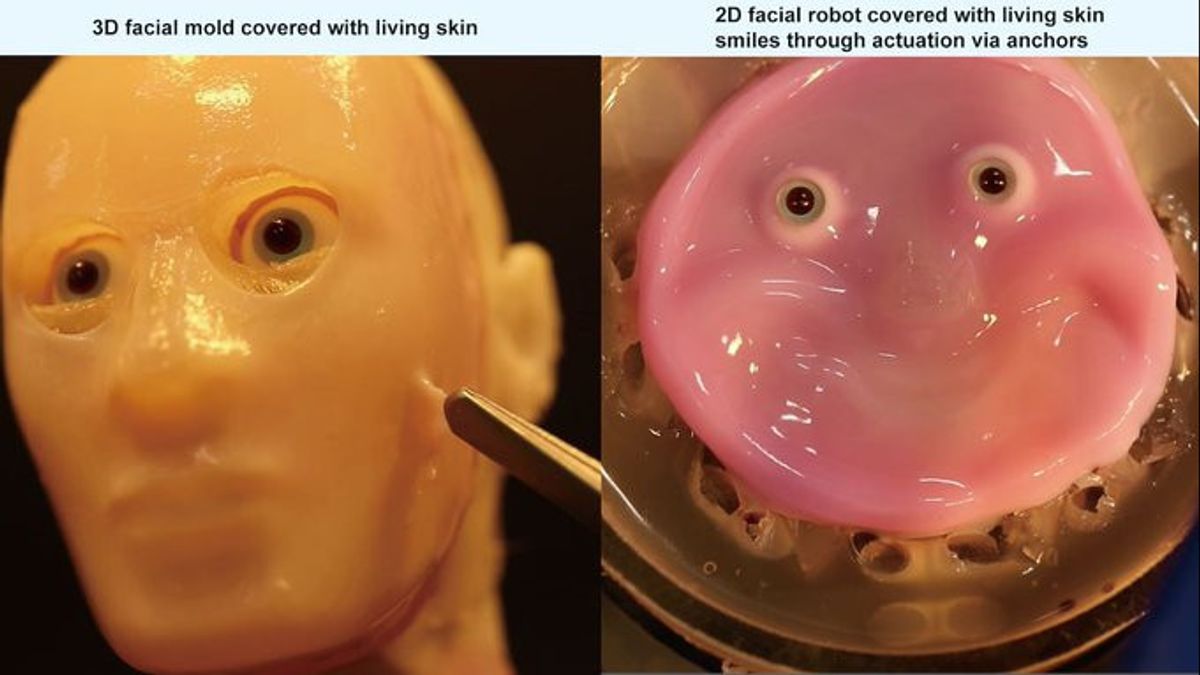JAKARTA - In a science fiction film like Alien, a humanoid robot is so similar to humans that it is almost impossible to distinguish it from natives. Now, scientists in Japan are heading to the creation of a real version of these realistic machines.
Experts from the University of Tokyo have created a robot face from human skin grown in the laboratory. This creepy video shows this pink creation trying to smile but it's awkward.
According to scientists, robots with real skin not only have 'looking more human-like' but can also heal themselves if injured. Experts make special formulations on the robot's face, which helps the skin layer stick
The research was led by Professor Shoji Takeuchi of the University of Tokyo and detailed in a new study on Cell Reports Physical Science.
Professor Takeuchi's laboratory has created a mini robot that runs using biological muscle tissues, tissues grown in 3D-printed laboratories, and self-healing skin.
"We managed to replicate human appearance to a certain extent by creating a face with the same surface materials and structures as humans," said Professor Takeuchi.
This engineered skin tissue is created by taking samples of human skin cells and growing them in a laboratory similar to how the cultivation meat is developed.
"These human skin cells are mostly taken from excess skin obtained during surgery. The cultivated skin has the same composition as human skin and is also used as grafted material for people with severe burns or injuries," said study author Michio Kawai. from Harvard University quoted by VOI from MailOnline
The engineered skin tissue and how to attach it to the complex structure of the robot's face are inspired by skin ligament in human tissue.
This scary new video shows this pink creation trying to smile awkwardly. The silicon layer is pulled at the corners of the mouth by an external mechanical actuator.
Although engineering the life skin of cell culture has its own challenges, the hardest part is making the skin stick to the face of a robot made of acrylic-based resin.
The previous method involved a mini anchor or hook, but this limits the type of surface that can receive a layer of skin and can cause damage during movement.
SEE ALSO:
Instead, the team used a special collagen gel for adhesion and made special perforations on the faces of their robots, helping the layer of skin planted in the laboratory stick.
By carefully engineering small perforations, they say that any surface shape can be coated with the skin.
While it was long before the robot could look like in the Alien franchise film, Professor Takeuchi and his colleagues believed that life's skin could bring new capabilities to the robot.
Robots with skin on their faces have self-healing abilities, embedded sensory abilities, and more human-like appearances.
"This study introduces an approach to attaching and moving the skin with a perforation-type anchor, which has the potential to contribute to progress in biohybridal robotics," they said in their paper.
"Unlike other self-healing materials, which require heat or pressure to trigger adhesion on a cut surface, equivalent skin can regenerate defects through cell proliferation without any triggers," the study said.
The next challenge is to create various human-like expressions by integrating advanced actuators, similar to muscles, in robots
The English, Chinese, Japanese, Arabic, and French versions are automatically generated by the AI. So there may still be inaccuracies in translating, please always see Indonesian as our main language. (system supported by DigitalSiber.id)
















